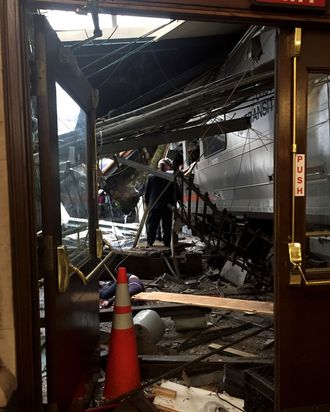
New Jersey Transit train #1614 was traveling at nearly twice the normal speed limit when it plowed into a Hoboken station last Thursday, killing one woman and injuring more than 100, federal officials say.
The train was reportedly going about 21 miles per hour when it blasted into the station; the normal speed limit is 10 miles per hour. It appears that the train operator pulled the emergency brake about a second before the crowded commuter train barreled into the terminal, according to officials.
The National Transportation Safety Board got this very preliminary information from the train’s second black-box recorder, which was finally recovered Tuesday, after crews had struggled to retrieve the device from the tangled mess of fallen debris. Investigators also pulled out the train’s front-facing camera and the train engineer’s cell phone. Another black-box recorder, in the back of the train, was very old and wasn’t working at the time of the crash.
The NTSB laid out an initial scenario that appears to contradict the testimony of the engineer, 48-year-old Thomas Gallagher. Gallagher told officials has no memory of the accident and came to on the floor of the car. He does recall checking the speedometer, which he said read 10 miles per hour as the train approached Lackawanna Station.
Yet the train did slow at some point before the fatal crash. According to investigators, about 38 seconds before the wreck, the train was cruising at 8 miles per hour and then accelerated when the train’s throttle was increased from the idle position. That quickly more than doubled the train’s speed. The engineer pulled the emergency break just a second before the train plowed into the bumper at the end of the station, but that failed to slow the train.
The agency’s most recent findings also seem to back up witness testimony, which reported that the train slammed into the station at “full force.”
NTSB also gathered some clues from the video camera, which showed the front car hitting and then “overriding the bumping post” at the end of track 5. A flash appeared on the video screen at the moment of the collision, officials say.
The NTSB stressed that these are just the preliminary findings — investigators still have to analyze all the data on the recorders and have not officially determined a cause of the crash. A full and complete report could take up to a year.
Jersey Transit still isn’t operating in and out of Hoboken, though crews began clearing the wreckage from the tracks Thursday. When the Hoboken station does reopen, the New York Times reports that all conductors will now have to join the engineers in the front car when the train is pulling into that station and the Atlantic City station — a pretty big change that was issued the day before the NTSB released its first findings about the crash.





























